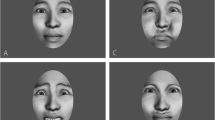Summary
The influence of stimulus form on the scalp-recorded “vertex positive peak” (VPP) evoked by images of faces (Jeffreys 1989a) was studied in seven subjects. In separate experiments, we recorded the responses to 2D images of: (1) many different depictions of human faces; (2) the heads of several different species; (3) many familiar non-face objects; and (4) stimuli where the configuration of objects were modified to produce an “illusory” or “non-contextual” subjective impression of a face. The results showed that every facial representation, including the “illusory” stimuli, and most of the non-face objects, evoked a VPP of corresponding form and scalp distribution. The object-evoked VPPs, however, were always smaller and usually later than those evoked by the faces. VPPs of longer latency but often comparable amplitude were also recorded for impoverished compared to well-defined facial representations; and for most non-human compared to human faces. Very consistent responses were recorded to repeated presentations of the same stimulus for the same subject, but there was considerable variation in latency as well as amplitude (but not form) of the VPP evoked under identical experimental conditions for different subjects. These response properties of the VPP, suggest that its underlying physiological generators are sensitive to basic configurai properties of the visual stimulus; and also that face- and object-related information are processed in the same brain area(s), although not necessarily by the same physiological mechanisms.
Similar content being viewed by others
References
Baylis GC, Rolls ET, Leonard CM (1985) Selectivity between faces in the responses of a population of neurons in the cortex of the superior temporal sulcus of the monkey. Brain Res 342: 91–102
Baylis GC, Rolls ET, Leonard CM (1987) Functional subdivisions of the temporal lobe neocortex. J Neurosci 7: 330–342
Bötzel K, Grüsser O-J (1989) Electric brain potentials evoked by pictures of faces and non-faces: a search for “face-specific” EEG potentials. Exp Brain Res 77: 349–360
Bruce C, Desimone R, Gross CG (1981) Visual properties of neurons in a polysensory area in superior temporal sulcus of the macaque. J Neurophysiol 46: 369–384
Campbell FW (1985) How much of the information falling on the retina reaches the visual cortex and how much is stored in the visual memory? In: Chagas C (ed) Pattern recognition mechanisms. Pontifical Academy of Science, Vatican City, pp 83–95
Deregowski JB (1989) Real space and represented space: crosscultural perspectives. Behav Brain Sci 12: 51–119
Desimone R (1991) Face-selective cells in the temporal cortex monkeys. J Cogn Neurosci 3: 1–8
Desimone R, Albright TD, Gross CG, Bruce C (1984) Stimulusselective properties of inferior temporal neurons in the macaque. J Neurosci 4: 2051–2062
Gross CG, Desimone R, Albright TD, Schwartz EL (1985) Inferior temporal cortex and pattern recognition. In: Chagas C (ed) Pattern recognition mechanisms. Pontif Acad Sci, Vatican City, pp 179–201
Hari R, Lounasmaa OV (1989) Recording and interpretation of cerebral magnetic fields. Science 244: 432–436
Hasselmo ME, Rolls ET, Baylis GC (1989) The role of expression and identity in the face-selective responses of neurones in the temporal visual cortex of the monkey. Behav Brain Res 32: 203–218
Jasper H (1958) Report of the committee on methods of clinical examination in electroencephalograph. Electroencephalogr Clin Neurophysiol 10: 370–375
Jeffreys DA (1989a) A face-responsive potential recorded from the human scalp. Exp Brain Res 78: 193–202
Jeffreys DA (1989b) Evoked potential studies of contour processing in human visual cortex. In: Kulikowski JJ, Dickinson CM, Murray IJ (eds) Contour and colour. Pergamon, London, pp 529–545
Jeffreys DA, Axford JG (1972) Source locations of pattern-specific components of human visual evoked potentials. I. Component of striate cortical origin; II. Component of extrastriate cortical origin. Exp Brain Res 16: 1–40
Jeffreys DA, Tukmachi ESA (1991a) Scalp potentials evoked by “illusory” face stimuli. Electroencephalogr Clin Neurophysiol 78:87P
Jeffreys DA, Tukmachi ESA (1991b) Human scalp potentials evoked by face images of different orientation. J Physiol (Lond) 438:299P
Jeffreys DA, Tukmachi ESA, Rockley G (1992) Evoked potential evidence for human brain mechanisms that respond to single, fixated faces. Exp Brain Res 91: 351–362
Lu ST, Hamalainen MS, Hari R, Ilmoniemi RJ, Lounasmaa OV, Sams M, Vilkman V (1991) Seeing faces activates three separate areas outside the occipital visual cortex in man. Neuroscience 43: 287–290
Perrett DI, Rolls ET, Caan W (1982) Visual neurons responsive to faces in the monkey temporal cortex. Exp Brain Res 47: 329–342
Perrett DI, Smith PAJ, Potter DD, Mistlin AJ, Head AS, Milner AD, Jeeves MA (1984) Neurones responsive to faces in the temporal cortex: studies of functional organization, sensitivity to identity and relation to perception. Hum Neurobiol 3: 197–208
Perrett DI, Mistlin AJ, Chitty AJ (1987) Visual neurones responsive to faces. Trends Neurosci 10: 358–364
Perrett DI, Mistlin AJ, Chitty AJ, Smith PAJ, Potter DD, Broennimann R, Harries M (1988) Specialized face processing and hemispheric asymmetry in man and monkey: evidence from single unit and reaction time studies. Behav Brain Res 29: 245–258
Shephard RN (1990) Mind sights. Freeman, New York
Smith AT, Jeffreys DA (1978) Size and orientation specificity of transient visual evoked potentials in man. Vision Res 18: 651–655
Tanaka K, Hide-Aki S, Fukuda Y, Moriya M (1991) Coding visual objects in the inferotemporal cortex of the macaque monkey. J Neurophysiol 66: 170–189
Author information
Authors and Affiliations
Rights and permissions
About this article
Cite this article
Jeffreys, D.A., Tukmachi, E.S.A. The vertex-positive scalp potential evoked by faces and by objects. Exp Brain Res 91, 340–350 (1992). https://doi.org/10.1007/BF00231668
Received:
Accepted:
Issue Date:
DOI: https://doi.org/10.1007/BF00231668




